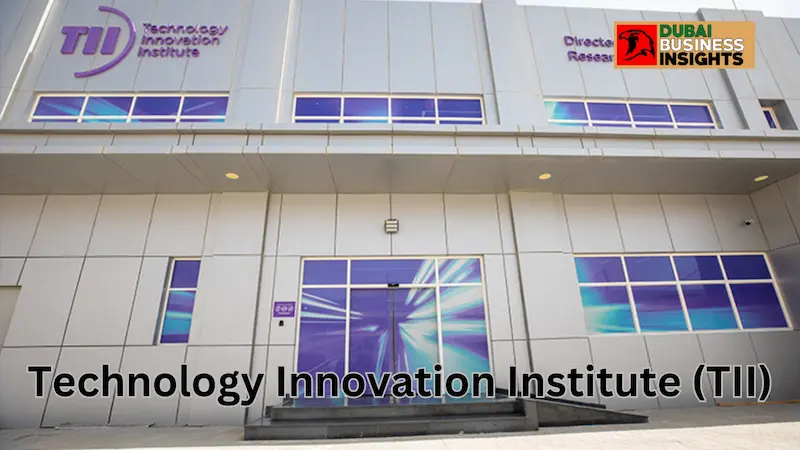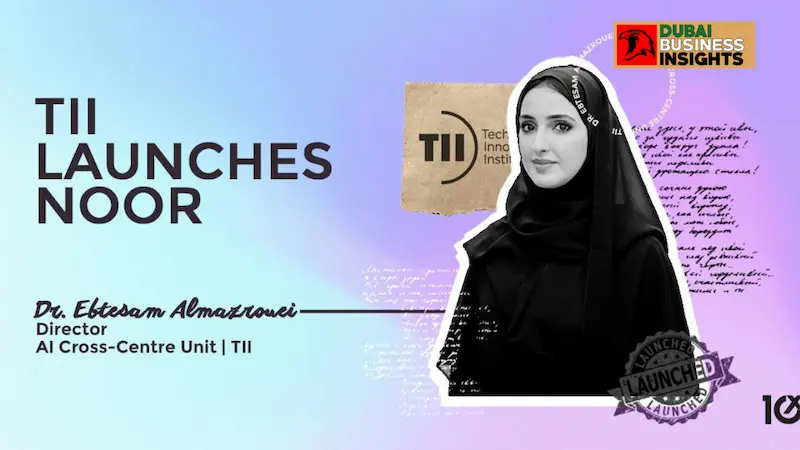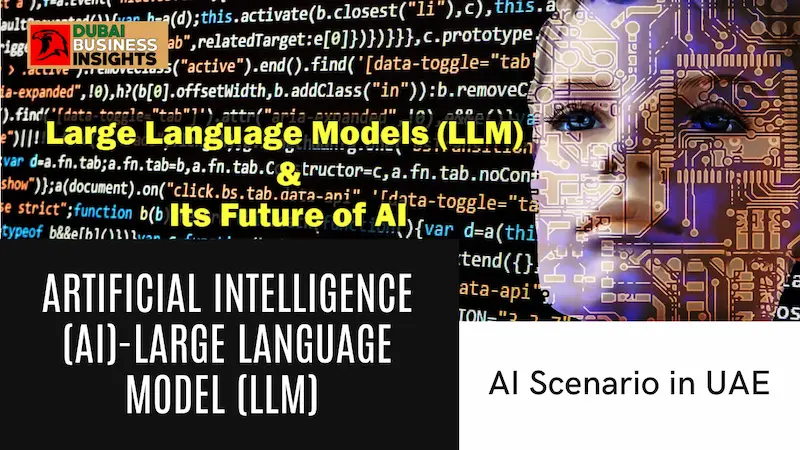Artificial Intelligence AI-Large Language Model LLM and AI Scenario in UAE: Artificial intelligence (AI) is the ability of machines to perform tasks that normally require human intelligence, such as understanding language, image recognition, decision-making, and learning from data. AI can be applied to various domains, such as healthcare, education, finance, Entertainment, and more.
Large language models (LLMs) are a type of AI that use deep learning and massive data sets, such as websites, articles, and books, to generate text, translate between languages, and write many types of content. LLMs can learn from billions of words and produce coherent and relevant texts on any topic.
LLMs have many benefits for different industries and applications. They can help create personalized product recommendations, provide round-the-clock customer support, automate content creation and marketing, predict future demand and optimize pricing, detect fraud and enhance security, enable visual search and augmented reality experiences, and more .
However, LLMs also pose some challenges and risks. They require a lot of computational resources and data to train and run. They may generate inaccurate or biased texts that can mislead or harm users. They may also raise ethical and legal issues regarding data privacy, ownership, and accountability .
In the UAE, LLMs are being used to advance the country’s vision of becoming a global leader in AI. For example, Falcon is an LLM developed by the UAE Ministry of Education that can generate educational content in Arabic and English for students and teachers. Noor is another LLM developed by the UAE Ministry of Health that can provide health information and advice in Arabic to the public. These are some of the examples of how LLMs are transforming the AI scenario in UAE.
Falcon: The first Arabic LLM

Falcon is a generative LLM that helps advance applications and use cases to future-proof our world. It is developed by the AI and Digital Science Research Center’s (AIDRC) AI Cross-Center Unit at Technology Innovation Institute (TII), which is a leading global scientific research center and the applied research foundation of Abu Dhabi’s Advanced Technology Research Council (ATRC).
Falcon is named after the national bird of the UAE, which symbolizes speed, agility, intelligence, and vision. Falcon is also an acronym for Foundational Arabic Language CONtextualized model.
Describe the development and features of Falcon
Falcon is built on the success of Noor, the world’s largest Arabic language model that was launched by TII in 2022. Noor has 7.5 billion parameters, which are the numerical values that determine how the model processes the input and output data. Noor was trained on more than 95 billion words from various sources, such as books, news articles, social media posts, and Wikipedia pages.
Falcon is an extension of Noor, with more parameters, more data, more features, and more capabilities. Falcon has four versions: Falcon 180B, Falcon 40B, Falcon 7.5B, and Falcon 1.3B. The number indicates the number of parameters in each version. For comparison, GPT-3, one of the most popular LLMs in the world, has 175 billion parameters.
Falcon is trained on one trillion tokens, which are units of text that can be words or parts of words. Falcon uses only 75 percent of GPT-3’s training compute, 40 percent of Chinchilla’s (a Chinese LLM), and 80 percent of PaLM-62B’s (a multilingual LLM).

Falcon has several features that make it unique and powerful:
- It is the first Arabic LLM that can generate text in both Modern Standard Arabic (MSA) and Arabic dialects.
- It can switch between different dialects based on the input or the context.
- It can translate between Arabic and other languages, such as English, French, Spanish, Chinese, etc.
- It can answer questions, summarize texts, write essays, create poems, generate captions for images or videos, etc.
- It can adapt to different domains or topics based on the input or the context.
- It can handle complex linguistic phenomena in Arabic, such as morphology (the structure of words), syntax (the structure of sentences), semantics (the meaning of words and sentences), pragmatics (the use of language in social situations), etc.
Highlight the applications and achievements of Falcon
Falcon has many applications and achievements that demonstrate its potential and impact for various sectors and users. Some examples are:
- Falcon was used to create a chatbot named ZayedBot that can interact with users in Arabic or English about various topics related to Sheikh Zayed bin Sultan Al Nahyan, the founding father of the UAE. ZayedBot can answer questions, provide facts, tell stories, and share quotes from Sheikh Zayed. ZayedBot was launched on the occasion of the UAE’s 50th National Day in 2021.
- Falcon was used to create a virtual assistant named Sara that can help students and teachers in online learning platforms. Sara can provide feedback, guidance, support, and motivation for learners and educators. Sara can also generate personalized learning content and assessments based on the learner’s level, preferences, and goals. Sara was tested in several schools and universities in the UAE and received positive feedback from users.
- Falcon was used to create a content generation tool named Noura that can produce high-quality and original text for various purposes, such as blogs, articles, reports, reviews, etc. Noura can write in different styles, tones, and formats based on the user’s input or request. Noura can also optimize the text for search engine optimization (SEO) by using relevant keywords and phrases. Noura was used by several media outlets and content creators in the UAE and the region.
- Falcon was used to create a poetry generation tool named Shihab that can compose poems in different forms, such as free verse, sonnet, haiku, etc. Shihab can also write poems in different languages, such as Arabic, English, French, etc. Shihab can also generate poems based on a given theme, mood, or image. Shihab was showcased at the Abu Dhabi International Book Fair in 2022 and received praise from poets and literary critics.
Discuss the limitations and future plans of Falcon
Falcon is a remarkable achievement for the UAE and the Arab world in the field of AI and LLMs. However, Falcon is not perfect and has some limitations that need to be addressed in the future. Some of these limitations are:
- Falcon is still dependent on large amounts of data to train and improve its performance. However, data is not always available or accessible for some domains or topics, especially in Arabic. Therefore, Falcon needs to develop more efficient and effective ways to learn from less data or from other sources of knowledge.
- Falcon is still vulnerable to errors or biases that may affect its quality or reliability. For example, Falcon may generate inaccurate or inappropriate text that does not match the input or the context. Falcon may also reflect some stereotypes or prejudices that exist in the data or in the society. Therefore, Falcon needs to develop more robust and ethical mechanisms to detect and correct such errors or biases.
- Falcon is still limited by the current hardware and software infrastructure that supports its development and deployment. For example, Falcon requires high computational power and storage capacity to train and run its models. Falcon also requires high bandwidth and connectivity to access its models and services online. Therefore, Falcon needs to develop more scalable and affordable solutions to overcome these challenges.
Falcon has a bright future ahead as it continues to grow and evolve with the help of TII and its partners. Some of the future plans of Falcon are:
- To expand its coverage and diversity by adding more languages, dialects, domains, topics, features, and capabilities to its models and services.
- To enhance its quality and reliability by improving its accuracy, consistency, coherence, relevance, creativity, and originality in generating text.
- To increase its accessibility and usability by making its models and services available for more platforms, devices, applications, and users.
- To foster its innovation and collaboration by engaging with more researchers, developers, companies, governments, organizations,
and communities in developing new applications and use cases for Falcon.
Falcon is a milestone for the UAE’s vision and leadership in AI and LLMs. Falcon is also a testament to the UAE’s commitment and contribution to advancing human knowledge and civilization. Falcon is not only a model but also a message: a message of hope, opportunity, and excellence for the UAE, the Arab world, and the world at large.

However, these LLMs are not the only ones in the world. In fact, there is a new challenger in the AI race: Falcon LLM, developed by the Technology Innovation Institute (TII), a leading global scientific research center and the applied research pillar of Abu Dhabi’s Advanced Technology Research Council (ATRC), based in Abu Dhabi, UAE. Falcon LLM is a foundational large language model with 40 billion parameters, which outperforms ChatGPT-3 in terms of quality and speed. Falcon LLM is trained on one trillion tokens, which are the units of text that the neural network processes. Falcon LLM uses only 75 percent of ChatGPT-3’s training compute, 40 percent of Chinchilla’s, and 80 percent of PaLM-62B’s. This means that Falcon LLM is more efficient and cost-effective than its competitors.
Comparison and contrast of Falcon and Noor
Compare the similarities and differences of Falcon and Noor in terms of size, performance, domain, etc.
Falcon and Noor are both large language models developed by TII’s AIDRC. They share some similarities and differences in terms of size, performance, domain, etc. Some of the similarities are:
- They both use the Transformer architecture, which is a state-of-the-art neural network design that enables parallel processing and long-range dependencies.
- They both use mixed precision training, which is a technique that reduces the memory usage and increases the speed by using different numerical formats for different parts of the computation.
- They both use AdamW optimizer, which is an algorithm that adjusts the learning rate and weight decay for each parameter during training.
- They both use Byte Pair Encoding (BPE), which is a method that splits the text into subword units based on frequency and co-occurrence.
Some of the differences are:
- Falcon has 40 billion parameters, while Noor has 223 billion parameters. This means that Noor is more than five times larger than Falcon.
- Falcon is trained on one trillion tokens from various sources and languages (mainly English), while Noor is trained on 560 billion tokens from Arabic sources only. This means that Falcon is more general-purpose and multilingual than Noor.
- Falcon can generate text for any domain and application (such as chatbots or content generation), while Noor can generate text for specific domains and applications related to Arabic language and culture (such as poetry or news). This means that Noor is more specialized and domain-adapted than Falcon.
- Analyze the strengths and weaknesses of Falcon and Noor in terms of quality, diversity, relevance, etc.
Falcon and Noor have different strengths and weaknesses in terms of quality, diversity, relevance, etc.

Some of the strengths are:
- Falcon has high quality and diversity in generating text for any domain and application. It can produce fluent, coherent, and informative text that covers a wide range of topics and styles. It can also handle different languages and dialects, such as English, Arabic, Hindi, Urdu, etc.
- Noor has high quality and relevance in generating text for Arabic language and culture. It can produce accurate, consistent, and authentic text that reflects the richness and diversity of Arabic literature, history, religion, etc. It can also handle different variants and forms of Arabic, such as Modern Standard Arabic, Classical Arabic, Dialectal Arabic, etc.
Some of the weaknesses are:
- Falcon may have low relevance and specificity in generating text for some domains and applications that require deep knowledge and expertise. It may not be able to capture the nuances and subtleties of some topics and styles that are domain-specific or culture-specific. It may also have some errors or biases in some languages or dialects that are underrepresented or low-resource.
- Noor may have low diversity and generality in generating text for some domains and applications that require creativity and novelty. It may not be able to produce original, diverse, and innovative text that goes beyond the existing data and knowledge. It may also have some limitations or difficulties in some languages or dialects that are not Arabic or related to Arabic.
- Evaluate the impact and potential of Falcon and Noor in terms of innovation, accessibility, collaboration, etc.
Falcon and Noor have different impact and potential in terms of innovation, accessibility, collaboration, etc. Some of the impact are:
- Falcon is a breakthrough in the field of AI and LLMs. It is one of the largest and fastest LLMs in the world that can generate text for any domain and application. It is also one of the first LLMs that is developed by a research center in the Middle East region. It showcases the UAE’s leadership and excellence in AI research and development.
- Noor is a milestone in the field of AI and Arabic NLP. It is the largest and most comprehensive LLM for Arabic language and culture. It is also one of the first LLMs that is dedicated to a specific language and culture. It showcases the UAE’s contribution and commitment to preserving and promoting Arabic language and culture.
Some of the potential are:
- Falcon can enable new possibilities and opportunities for various domains and applications that can benefit from natural language generation. It can also empower users from different backgrounds and locations to access and use AI technology in their own languages and dialects.
- Noor can enable new possibilities and opportunities for Arabic language and culture that can benefit from natural language generation. It can also empower users from Arabic-speaking countries and communities to access and use AI technology in their own language and culture.
Conclusion
we have discussed the concept of artificial intelligence (AI) large language models (LLMs) and their applications and challenges in the UAE. We have seen how LLMs can generate natural and fluent texts for various purposes, such as summarizing, translating, answering questions, and creating content. We have also explored some of the ethical and social implications of using LLMs, such as bias, privacy, accountability, and regulation.
As the UAE is a leading country in the field of AI, it has a great opportunity to leverage the power of LLMs to enhance its innovation and competitiveness. However, it also faces some risks and responsibilities to ensure that LLMs are used in a safe and beneficial way for its society and culture. Therefore, we recommend that LLM users and developers in the UAE follow some best practices, such as:
- Evaluating the quality and reliability of the LLM-generated texts before using them for any critical or sensitive tasks
- Acknowledging the source and limitations of the LLM-generated texts when sharing or publishing them
- Respecting the intellectual property rights and privacy of the original authors and data sources of the LLM-generated texts
- Seeking informed consent and feedback from the stakeholders and beneficiaries of the LLM-generated texts
- Adhering to the ethical principles and guidelines of the UAE AI Strategy and the UAE AI Ethics Advisory Board
We hope that this blog post has given you some useful information and insights about LLMs and their role in the UAE. If you have any questions or comments, please feel free to leave them below. Thank you for reading!
Artificial Intelligence AI-Large Language Model LLM and AI Scenario in UAE
FAQ
Q: What is the role of Large Language Models (LLMs) in advancing the UAE’s vision of becoming a global leader in AI?
A: LLMs play a crucial role in supporting the UAE’s AI initiatives by generating educational content, providing health information, and contributing to various AI applications.
Q: What are the similarities and differences between Falcon and Noor, two prominent LLMs developed in the UAE?
A: Falcon and Noor share similarities in their use of the Transformer architecture but differ in terms of size, multilingual capabilities, and domain specificity.
Q: What are some of the limitations of Falcon and Noor, and how can they be addressed in the future?
A: Both Falcon and Noor face challenges related to data availability, potential errors or biases, and infrastructure. Future plans involve addressing these limitations to improve efficiency and reliability.
Q: What impact do Falcon and Noor have on innovation, accessibility, and collaboration in the field of AI and natural language processing?
A: Falcon and Noor contribute to innovation, provide accessibility for various languages and cultures, and foster collaboration in AI research and development in the UAE.
Q: What ethical considerations should users and developers of LLMs in the UAE keep in mind to ensure the responsible and ethical use of AI technology?
A: Users and developers should consider factors like evaluating the quality of generated content, acknowledging sources, respecting privacy, seeking informed consent, and adhering to ethical guidelines to ensure responsible AI use.

